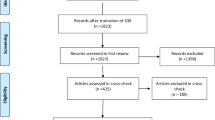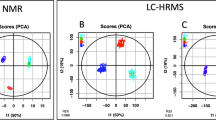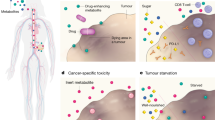Abstract
Whereas other components of the National Institutes of Health support the discovery and subsequent development of novel chemical entities into drugs, the National Center for Complementary and Alternative Medicine (NCCAM) studies complex natural products that are marketed as dietary supplements. This article contrasts the regulatory framework for dietary supplements and drugs, outlines the challenges of evaluating dietary supplements for safety and clinical effectiveness, and describes the evolving drug model for botanicals.
This is a preview of subscription content, access via your institution
Access options
Subscribe to this journal
Receive 12 print issues and online access
$209.00 per year
only $17.42 per issue
Buy this article
- Purchase on Springer Link
- Instant access to full article PDF
Prices may be subject to local taxes which are calculated during checkout






Similar content being viewed by others
References
Eisenberg, D. M. et al. Trends in alternative medicine use in the United States, 1990–1997. J. Am. Med. Assoc. 280, 1569—1575 (1998).
Kessler, R. C. et al. Long-term trends in the use of complementary and alternative medical therapies in the United States. Ann. Intern. Med. 135, 262—268 (2001).
Goldbeck-Wood, S. et al. Complementary medicine is booming worldwide. Br. Med. J. 313, 131–133 (1996).
House of Lords Session 1999–2000, Select Committee on Science and Technology, Sixth Report, Complementary and Alternative Medicine, 21 November 2000.
Astin, J. A. Why patients use alternative medicine: results of a national study. J. Am. Med. Assoc. 279, 1548—1553 (1998).
Clark, A. M. Natural products as a resource for new drugs. Pharm. Res. 13, 1133—1141 (1996).
Tyler, V. E., Brady, L. R. & Robbers, J. E. Pharmacognosy 9th edn (Lea & Febiger, Philidelphia, 1988).
Schultz, V., Hansel, R. & Tyler, V. E. Rational Phytotherapy: A Physician's Guide to Herbal Medicine 4th edn (Springer, Berlin, 2001).
Expanding Horizons of Healthcare: Five-Year Strategic Plan, 2001–2005, National Center for Complementary and Alternative Medicine, National Institutes of Health.
Pub L no. 75–717, 52 Stat 1040 (1938) 21 USC 9 (Food Drug and Cosmetic Act 1938).
Pub L no. 87–781, § 102(c), 76 Stat 780 (1962) (codified at 21 USC § 355(d)(5)) (Kefauver Harris Amendment of 1962).
Pub L no. 103–417, 108 Stat 4325 (1994) 21 USC 231 (The Dietary Supplement Health and Education Act of 1994).
Bass, I. S. & Raubicheck, C. J. Marketing Dietary Supplements (Food and Drug Law Institute, Washington DC, 2000).
Federal Register. House Government Reform Committee. Six Years After the Enactment of DSHEA: The Status of National and International Dietary Supplement Regulation (March 20, 2001).
Blumenthal, M. in The Complete German Commission E Monographs: Therapeutic Guide to Herbal Medicines (eds Blumenthal, M. et al.) 17 (American Botanical Council, Austin, Texas, 1998).
Harkey, M. R., Henderson, G. L., Gershwin, M. E., Stern, J. S. & Hackman, R. M. Variability in commercial ginseng products: an analysis of 25 preparations. Am. J. Clin. Nutr. 73, 1101—1106 (2001).
Pub L no. 96–517, 94 Stat 3018 (1980) (codified at 35 USC 200 et seq) (The Bayh–Dole Act of 1980).
Pub L no. 99–502, 100 Stat 1785 (1986) (codified at 15 USC § 3710 (a)) (Amendment to the Stevenson–Wydler Technology Innovation Act of 1980, commonly known as the Federal Technology Transfer Act of 1986).
Exploring Opportunities for Collaboration with Industry. National Center for Complementary and Alternative Medicine, National Institutes of Health, 2001.
Engel, L. W., Weinberg, M. S., Coates, P. M. and the Colloquium Planning Group. NCCAM-Industry Colloquium: exploring opportunities for collaboration. J. Altern. Complement. Med. 7, 579—582 (2001).
Guidance for Industry: Botanical Drug Products. Draft Guidance, Center for Drug Evaluation and Research, US Food and Drug Administration, 2000.
Kaptchuk, T. J. & Eisenberg, D. M. Varieties of healing. 2: A taxonomy of unconventional healing practices. Ann. Intern. Med. 135, 196–204 (2001).
Hoffman, F. A. & Rheinstein, P. in Legal Medicine 5th edn (eds Sanbar, S. S. et al.) 560–584 (Mosby, St Louis, 2001).
Klayman, D. L. Qinghaosu (artemisinin): an antimalarial drug from China. Science 228, 1049–1055 (1985).
Meshnick, S. R., Taylor, T. E. & Kamchonwongpaisan, S. Artemisinin and the antimalarial endoperoxides: from herbal remedy to targeted chemotherapy. Microbiol. Rev. 60, 301–315 (1996).
Porter, R. The Greatest Benefit to Mankind: a Medical History of Humanity from Antiquity to the Present (Harper Collins, London, 1997).
Lemli, J. Senna — an old drug in modern research. Pharmacology 36, 3–6 (1988).
Franz, G. The senna drug and its chemistry. Pharmacology 47, 2–6 (1993).
World Health Organization (WHO). WHO Monographs on Selected Medicinal Plants Vol. 1 (WHO, Geneva, 1999).
Acknowledgements
The authors thank I. Scott–Bass, J. Betz, R. Temple, J. Thompson and R. Upton for their critical reading of the manuscript and helpful input. We are especially grateful to J. Tisch for meticulously researching background materials.
Author information
Authors and Affiliations
Corresponding author
Related links
Glossary
- AYURVEDA
-
Ayurveda is India's traditional system of medicine. Ayurvedic medicine (meaning “science of life”) is a comprehensive system of medicine that places equal emphasis on the body, mind and spirit, and strives to restore the innate harmony of the individual. Some of the primary Ayurvedic treatments include diet, exercise, meditation, herbs, massage, exposure to sunlight and controlled breathing.
- BAYH–DOLE ACT OF 1980
-
The Bayh–Dole Act of 1980 guarantees organizations/investigators the right to patent and retain title to their inventions from research sponsored with government funds. The law was enacted to promote the transfer, commercialization and utilization of federally funded technologies.
- BIOFEEDBACK
-
A process for monitoring a body function (such as breathing, heart rate and blood pressure), and altering the function through relaxation or imagery.
- CHEMISTRY, MANUFACTURING AND CONTROLS
-
(CMCs). Extensive, detailed documentation of the drug under study, including its structural formula, animal-testing results and manufacturing information, all of which are required for an investigational new drug (IND) application.
- CHIROPRACTIC
-
A system of treatment that is based on the relationship between structure (primarily the spine) and function, and how that relationship affects the preservation and restoration of health.
- COOPERATIVE RESEARCH AND DEVELOPMENT AGREEMENT
-
(CRADA). A provision of the Federal Technology Transfer Act of 1986 that permits the directors of government-operated Federal laboratories to enter into cooperative research and development agreements on behalf of such agencies with other Federal agencies, units of state or local government, industrial organizations, public and private foundations, and nonprofit organizations (including universities).
- DIETARY SUPPLEMENT
-
A dietary supplement is a product that: contains one or more ingredients (such as vitamins and minerals, and herbs or botanicals) that is intended to supplement the diet; is intended for human use; is a tablet, capsule, powder or some other form that is “not represented as conventional food [or] for use as a sole item of a meal or diet,”; passes through the alimentary canal; and was not a new drug or biological before being marketed as a dietary supplement or food in this country.
- GOOD MANUFACTURING PRACTICES
-
(GMPs). Systems, processes and controls that are used in the manufacture of consumer products, particularly FDA-regulated products, that help to ensure the quality of finished goods.
- HERBS
-
Plants or plant products that produce or contain chemicals that act on the body.
- HERBAL THERAPIES
-
Individual herbs or mixtures of herbs that are used for therapeutic value.
- HOMEOPATHY
-
A Western system of medicine that is based on the principle that 'like cures like', — that is, the same substance that in large doses produces the symptoms of an illness, in very minute doses cures it. Homeopathic physicians believe that the more dilute the remedy, the greater its potency. Therefore, homeopaths use small doses of specially prepared plant extracts and minerals to stimulate the body's defence mechanisms and healing processes in order to treat illness.
- INVESTIGATIONAL NEW DRUG (IND) APPLICATION
-
A request for authorization from the US Food and Drug Administration (FDA) to administer an investigational drug or biological product to humans.
- MASSAGE
-
The manipulation of the soft tissues of the body to normalize those tissues.
- MEDITATION
-
A self-directed practice for relaxing the body and calming the mind in which the meditator makes a concentrated effort to focus on a single thought in order to still the mind's inclination to mull over the thousands of demands and details of daily life.
- NATUROPATHIC MEDICINE
-
A system of treatment that views disease as a manifestation of alterations in the processes by which the body naturally heals itself. It emphasizes health restoration as well as disease treatment. Naturopathic physicians use an array of healing practices, including diet and clinical nutrition; homeopathy; acupuncture; herbal medicine; hydrotherapy (the use of water in a range of temperatures and methods of applications); spinal and soft-tissue manipulation; physical therapies involving electric currents, ultrasound and light therapy; therapeutic counselling; and pharmacology.
- QI GONG
-
Qi (pronounced chi) gong is a component of traditional oriental medicine that combines movement, meditation and the regulation of breathing to enhance the flow of vital energy (qi) in the body, to improve blood circulation and to enhance immune function.
- REIKI
-
Meaning Universal Life Energy, Reiki is based on the belief that by channelling spiritual energy through the practitioner the spirit is healed, and it in turn heals the physical body.
- SPECIAL DIET
-
A special diet therapy that is believed to prevent and/or control illness and/or promote health, such as those proposed by Drs Atkins, Ornish and Pritikin.
- THERAPEUTIC TOUCH
-
Therapeutic touch is derived from the ancient technique of 'laying-on of hands', and is based on the premise that it is the healing force of the therapist that affects the patient's recovery and that healing is promoted when the body's energies are in balance.
- TRADITIONAL ORIENTAL MEDICINE
-
Traditional oriental medicine emphasizes the proper balance or disturbances of qi — or vital energy — in health and disease, respectively. Traditional oriental medicine consists of a group of techniques and methods, including acupuncture, herbal medicine, oriental massage and qi gong (a form of energy therapy).
Rights and permissions
About this article
Cite this article
Engel, L., Straus, S. Development of therapeutics: opportunities within complementary and alternative medicine. Nat Rev Drug Discov 1, 229–237 (2002). https://doi.org/10.1038/nrd750
Issue Date:
DOI: https://doi.org/10.1038/nrd750
This article is cited by
-
The synergism of Clinacanthus nutans Lindau extracts with gemcitabine: downregulation of anti-apoptotic markers in squamous pancreatic ductal adenocarcinoma
BMC Complementary and Alternative Medicine (2019)
-
Chondroprotective potential of Phyllanthus amarus Schum. & Thonn. in experimentally induced cartilage degradation in the explants culture model
In Vitro Cellular & Developmental Biology - Animal (2015)
-
Complementary alternative medicine use among patients with type 2 diabetes mellitus in the primary care setting: a cross-sectional study in Malaysia
BMC Complementary and Alternative Medicine (2013)
-
Aluminum ammonium sulfate dodecahydrate purified from traditional Chinese medicinal herb Korean monkshood root is a potent matrix metalloproteinase inhibitor
BioMetals (2012)
-
A survey of complementary and alternative medicine in Iran
Chinese Journal of Integrative Medicine (2012)



